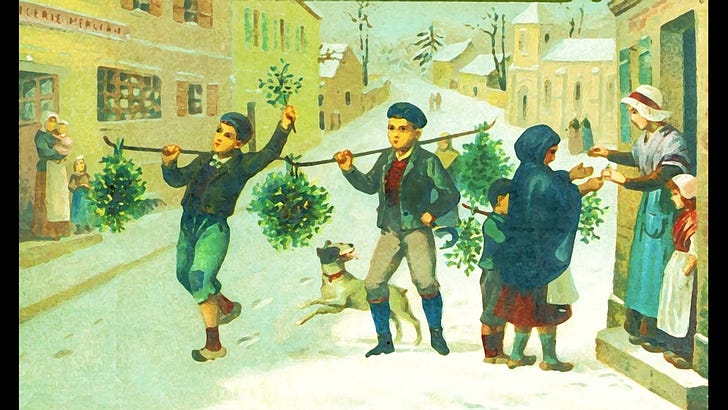TWA for Saturday, December 24, 2016
“For Maia” by Gary Johnson. Used by permission of the author.
ORIGINAL TEXT AND AUDIO - 2016
Today is Christmas Eve. One of the best modern Christmas Eve stories is a true one, and it happened in 1914, in the trenches of World War I. The “war to end all wars” was raging, but German and British soldiers had been engaging in unofficial ceasefires since mid-December. The British High Command was alarmed, and warned officers that fraternization across enemy lines might result in a decreased desire to fight. On the German side, Christmas trees were trucked in and candles lit, and on that Christmas Eve in 1914, strains of Stille Nacht — “Silent Night” — reached the ears of British soldiers. They joined in, and both sides raised candles and lanterns up above their parapets. When the song was done, a German soldier called out, “Tomorrow is Christmas; if you don’t fight, we won’t.”
The next day dawned without the sound of gunfire. The Germans sent over some beer, and the Brits sent plum pudding. Enemies met in no man’s land, exchanging handshakes and small gifts. Someone kicked in a soccer ball, and a chaotic match ensued. Details about this legendary football match vary, and no one knows for sure exactly where it took place, but everyone agrees that the Germans won by a score of three to two.
At 8:30 a.m. on December 26, after one last Christmas greeting, hostilities resumed. But the story is still told, in a thousand different versions from up and down the Western Front, more than a century later.
On Christmas Eve in 1906, the first radio program was broadcast. Canadian-born Professor Reginald Aubrey Fessenden sent his signals from the 420-foot radio tower of the National Electric Signaling Company, at Brant Rock on the Massachusetts seacoast. Fessenden opened the program by playing “O Holy Night” on the violin. Later he recited verses from the Gospel of St. Luke, then broadcast a gramophone version of Handel’s “Largo.” His signal was received up to five miles away.
It’s the birthday of tycoon, aviation pioneer, and film producer Howard Hughes (1905). Hughes was born Houston, Texas and was once the richest person in the world.
Howard Hughes spent the 1930s and 1940s immersed in aviation technology, building custom aircraft for himself and for the military. He set a flight record in 1938 when he flew around the world in 91 hours (3 days, 19 hours, and 17 minutes). He was severely injured in a plane crash (1946) when his plane decimated three houses near the Los Angeles Country Club and burst into flame. His heart was shifted to the right side of his chest cavity, and he survived, but he suffered addiction to opiates for the rest of his life.
Hughes had always been eccentric, and may even have suffered from obsessive-compulsive disorder, but his behavior intensified during the 1950s. He was so afraid of germs that he used tissues to pick up objects. He fell into such a severe depression that he didn’t leave his private screening room for four months, playing the same film on a loop and eating only chocolate, chicken, and milk. At one point, he moved into a bungalow at the Beverly Hills Hotel and stayed for a year, spending $11 million. Howard Hughes died in 1976.
Be well, do good work, and keep in touch.®
If you have a little left to give, please consider to support our newsletter effort by:
Stop by our Store and select what works for you - CLICK HERE
Send a check to: Prairie Home Productions, P.O. Box 2090, Minneapolis, MN 55402
*Clicking the Subscribe button (though this is free, you can make a paid contribution)
(We have 86, 747 subscribers and 1631 chose to support this newsletter by signing up as a “paid” subscription - THANK YOU!)



